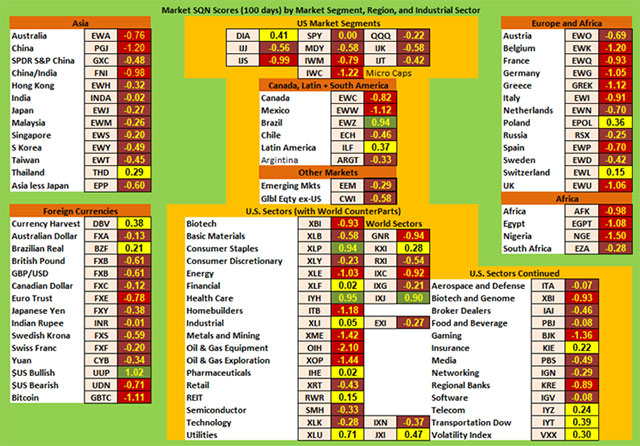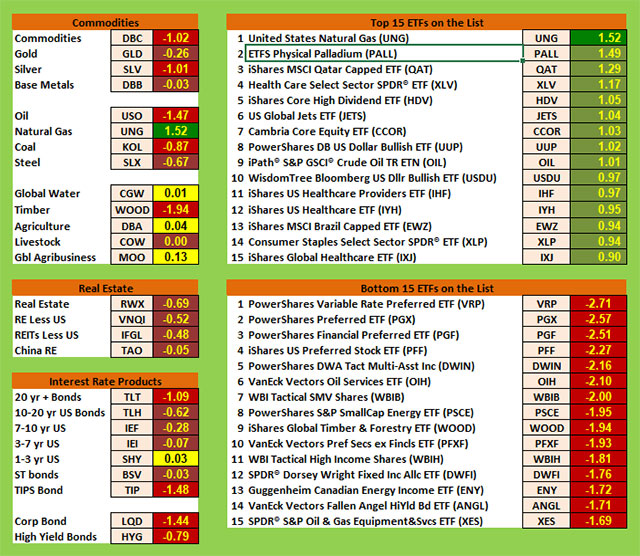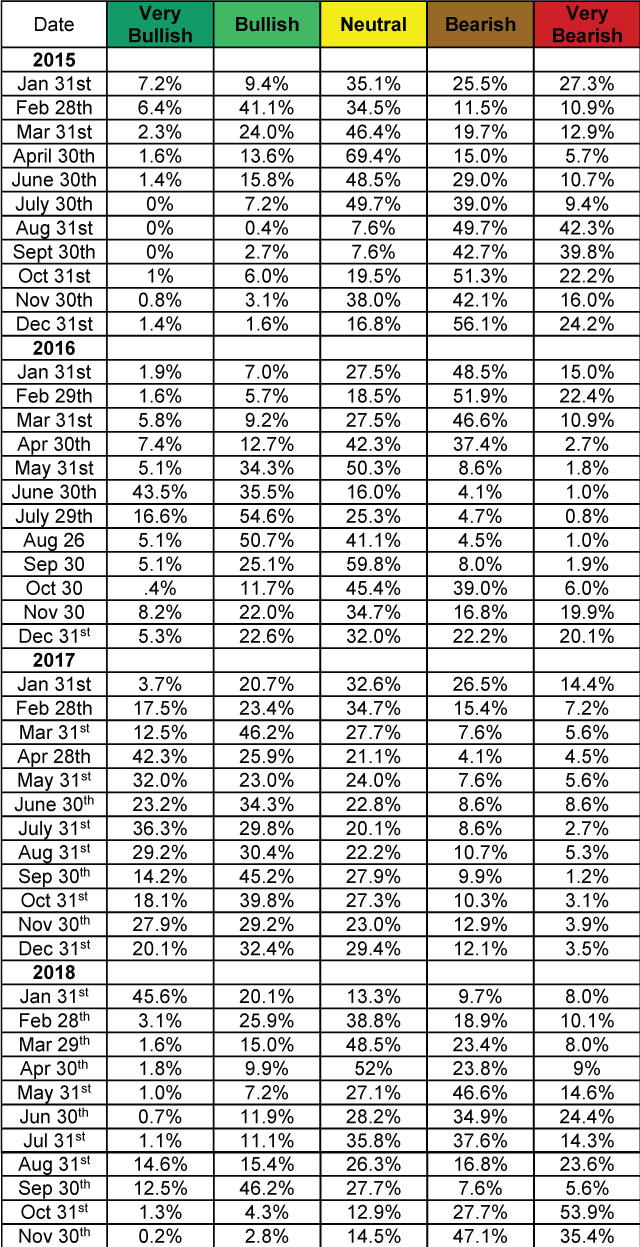November 2018 SQN Report
by Van K. Tharp, PhD
There are numerous ETFs that track everything from countries, commodities, currencies and stock market indices to individual market sectors. ETFs provide a wonderfully easy way to discover what’s happening in the world markets. I apply a version of my System Quality Number® (SQN®) score to measure the relative performance of numerous markets in a world model.
The Market SQN score uses the daily percent change for input over a 100-day period. Typically, a Market SQN score over 1.47 is strongly bullish and a score below -0.7 is very weak. The following color codes help communicate the strengths and weaknesses of the ETFs in this report:
- Dark Green: ETFs with very strong Market SQN scores > 1.47
- Light Green: ETFs with strong Market SQN scores (0.70 to 1.47).
- Yellow: ETFs with slightly positive Market SQN scores (0 to 0.70). These are Neutral/Sideways
- Brown: ETFs with slightly negative Market SQN scores (0 to -0.7).
- Red: Very weak ETFs that earn negative Market SQN scores (< -0.7).
This is basically the same rating scale that we use for the Market SQN Score in the Market Update. The world market model spreadsheet report below contains a cross section of currently available ETFs; excluding inverse funds and leveraged funds. In short, it covers equity markets around the globe, major asset classes, equity market segments, industrial sectors, and major currencies.
World Market Summary — Equities & Currencies
Each month we look at the equities markets across the globe by segment, region, and sector. The US Dollar continued its strength in October and is the only green currency, although it’s now light green. Since everything in the database is in the US dollar, it will make foreign assets seem weaker – and that’s the way the entire chart looks. Asia, Europe, and the rest of the Americans look pretty weak and even US market segments are now looking weak.
In the US, where the entire market is red and brown except for one yellow segment, the Dow Industrials. Elsewhere in the Americas, it is not so good either. Brazil is light green, Latin America is yellow and everything else is either red or brown.
Asia is mostly brown with three reds, Australia, China and China/India. And it has one yellow – Thailand.
Europe is pretty much the same – mostly red and brown. There are two yellows – Poland and Switzerland.
In currencies, the only green currency ETF is the USD (UUP). The currency harvest ETF is yellow as is the Brazilian real. The remainder of the currencies are brown except for the Euro and Bitcoin (which I added recently) which are both red. In the market sectors, we have two green US sectors only – just like last month. They are consumer staples and health care – with health care replacing utilities as a green. There are nine yellow sectors – financials, industrials, pharmaceutical, REITs, utilities, insurance, telecom, Dow transports, and volatility. All the remaining sectors are red and brown.
Commodities, Real Estate, Debt, and the Top and Bottom Lists
Commodities are still weak in October with only natural gas (like the last two months) being green. Global water, agriculture, and global agribusiness are all yellow. But everything else, including the blended commodities ETF are red and brown.
Real estate across the board looks weak with everything being brown but last month they were all red. Interest rate products are looking bad, with everything being red or brown. The only yellow is the 1-3 year bonds
The top 15 list last month had 8 dark green ETFs while this month it has only one (natural gas). Everything else on the top list is light green. Last month there were two ETFs showing Market SQN® scores greater than 5 which I had never seen before. These were short term interest rate ETFs but they have disappeared off the charts this month.
On the down side, the worst 15 ETFs are all red with 8 of them having scores lower than minus 2.0. The worst ETF is the variable rate preferred ETF. Preferred ETFs are four of worst performing ETFs on our list.
Summary
Let’s look at the summary table which measures the percentage of ETFs in each of the strength categories. You can see the distribution of the database by Market SQN score in bullish, neutral and bearish categories below –
The market was quite weak at the end of October with 5.6% of all sectors being bullish and 81.6% being bearish. On Nov 30th, only 3% were bullish which while 82.5% were bearish. We have been keeping up with this data since the beginning of 2015 and the last two months were by far the most bearish months in that four-year period.
I have no idea whether this market will stay where it is and become sideways, get worse, or recover. Just pay attention to what the market is doing.
Be careful to base your actions upon what IS happening, not what you think might happen. The markets always offer opportunities, but to capture those opportunities, you MUST know what you are doing. If you want to trade these markets, you need to approach them as a trader, not a long-term investor. We’d like to help you learn how to trade professionally because trying to navigate the markets without an education is hazardous to your wealth. All the beliefs given in this update are my own. Though I find them useful, you may not. You can only trade your own beliefs about the markets.
Until next month this is Van Tharp.




I precisely desired to thank you so much again. I do not know the things that I might have taken care of without these advice documented by you relating to such a problem. It actually was a depressing dilemma for me personally, however , being able to view a well-written way you dealt with the issue forced me to cry over fulfillment. I’m just happier for your assistance and thus expect you realize what a great job that you’re putting in educating other individuals using your blog. Most likely you’ve never encountered any of us.